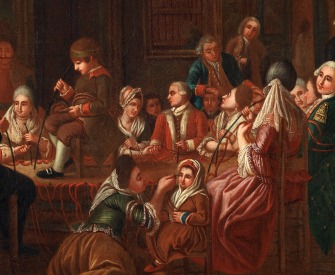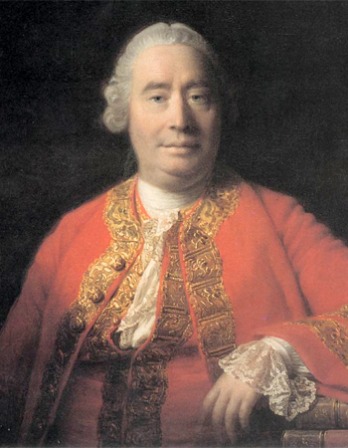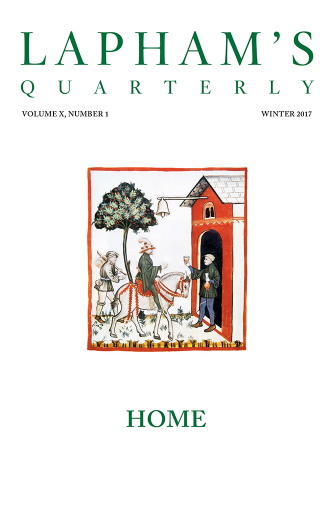The proof of the pudding is in the eating.
—Miguel de Cervantes, 1615Balanced Diets
Pica is an unexplainable food curiosity—the overwhelming desire to eat the inedible.
By Daniel Mason

The Harvesters, by Pieter Bruegel the Elder, 1565. The Metropolitan Museum of Art, Rogers Fund, 1919.
On June 6, 1800, nearly a year into his scientific journey through South America, Alexander von Humboldt arrived at a mission on the Orinoco River called La Concepción de Uruana. It was a stunning site. The village sat at the foot of granite mountains, amidst huge pillars of stone that rose above the forest. Weeks before, Humboldt had seen mysterious etchings on the summits of such rocks—painted, the natives told him, by ancestors carried up there by the waters of a great flood.
Although weakened by bouts of fever and hunger, Humboldt was in fine spirits. In the preceding months he had watched the Leonid meteor shower fill the sky, experienced his first earthquake, and confirmed the communication of the Orinoco and the Amazon rivers through the Casiquiare Canal. He had collected electric eels and watched the dissection of a manatee. If at times the mosquitoes were so thick as to obscure the horizon and prevent his reckoning of latitude, or if other times ant hordes filled his canoe, he pushed on, spurred, he wrote, by an uncertain longing “for what is distant and unknown.”
Humboldt and his botanist companion Aimé Bonpland (and Indian servants, and pressed plants, and jars of preserving spirits, and a chattering menagerie of birds and monkeys in cages on his boats) stayed at Uruana for only one day, conversing with the missionary Fray Ramon Bueno and visiting the Otomac villagers. For all of nature’s splendors, it was the people of Uruana that most caught Humboldt’s attention: “a tribe in the rudest state,” “considered dirty even by their neighbors,” “ugly, savage, vindictive, and passionately fond of fermented liquors,” and yet presenting “one of the most extraordinary physiological phenomena” Humboldt had ever seen. The Otomacs ate earth, “a prodigious quantity” of it. During the two to three months of the rainy season, when the high and turbulent waters of the river made fishing difficult, they claimed to eat nothing but.
Four years after his return, in the first edition of Aspects of Nature, published in 1808, Humboldt described the particular qualities of the earth, called poya: “a soft, unctuous clay, a true potter’s clay, of a yellowish-gray color,” gathered from specific sites along the Orinoco’s banks. And while Humboldt didn’t watch the Otomacs eat poya himself, he observed the great stores of clay balls that they had provisioned for the winter.
By then, Humboldt was one of the most famous men in Europe, and his report of this peculiar habit didn’t go unnoticed. “This claim has become the subject of a lively dispute,” he wrote, and to bolster his assertions, he cited other examples reported from across the torrid zone: the caouac clay eaten by the “Negroes of Guinea,” the mud cakes called tana ampo sold in Javan markets, the fist-sized pieces of friable steatite loved by the natives of New Caledonia. He had seen women on the banks of the Magdalena River eat their potting clay. Wolves, he wrote, ate clay in winter.
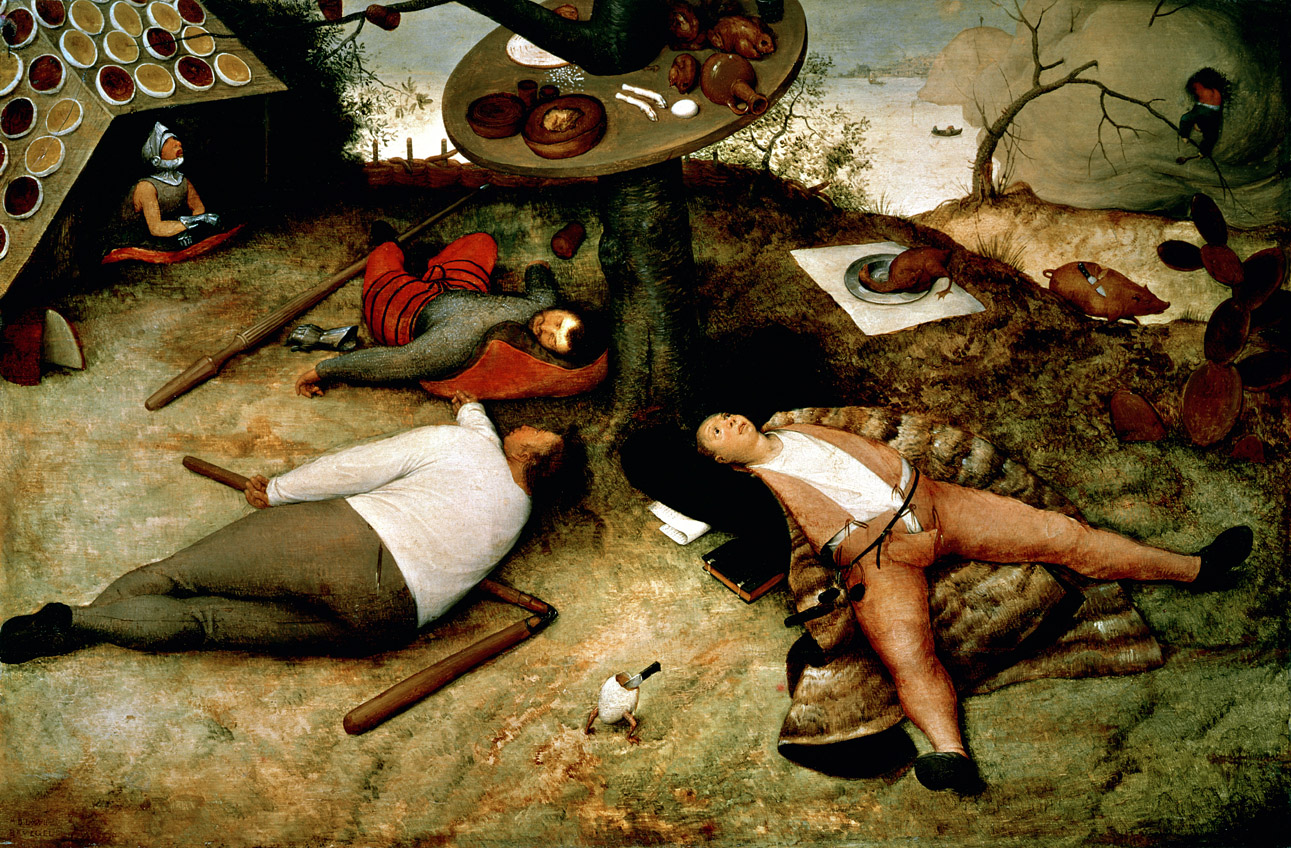
The Land of Cockaigne, by Pieter Bruegel the Elder, 1567. Alte Pinakothek, Munich.
However lurid, the story was more than just a traveler’s yarn about the savages. Humboldt noted natives eating millipedes, Marimonda monkeys, gum resins, ants; he diligently reported stories of cannibalism. But none raised the same physiologic speculation. “Tell me what you eat, and I shall tell you what you are,” wrote Anthelme Brillat-Savarin, in 1825, the year that the final volume of Humboldt’s Travels was published in France. Indeed, we have long defined ourselves and others by what we do and do not eat, from kashrut dietary restrictions described in Leviticus to the naming of Comanche bands (Kotsoteka—buffalo eaters, Penateka—honey eaters, Tekapwai—no meat) to insults—French frogs, English limeys, German krauts. But poya seemed to beg a different question: what was one to make of people who ate food that wasn’t food at all?
“Is earth capable of being assimilated?” asked Humboldt. “Or is it simply ballast for the stomach, to appease hunger? These are questions I cannot answer.”
The Depravity of Lovesick Girls
The purposeful ingestion of things not typically considered food is known today as pica, after the Latin word for magpie, a bird once held to have promiscuous tastes. It is a term of shifting boundaries. Some have used it to describe any indiscriminate eating, from the scavenging seen in some forms of mental illness to the calculated consumption of a Cessna 150 by French performance artist (and Guinness World Record Holder for Strangest Diet) “Monsieur Mangetout.” In its most common form, it consists of geophagy (the eating of earth), amylophagy (starch) or pagophagy (ice); but also trichophagy (hair), xylophagy (wood or paper), chalk and charcoal, detergent, baby powder, ash. Given that several of these substances, like ice, are consumed under quite ordinary circumstances, most descriptions of pica imply something capricious, uncontrollable, or mysterious. The craving might be so strong that cravers carry coolers of ice or clay in their purses. Migrants might ask their families to mail them clay from home. One seventy-seven-year-old woman in a case report from 1981 said that her craving for gymnastic chalk was invading her dreams.
When Humboldt had embarked on his expedition, pica was well known to Western medicine, noted particularly in pregnant women and children, and associated since Hippocrates with a particularly feminine syndrome of pallor and malaise known most famously as green sickness or chlorosis. The cause of chlorosis was far from settled, but an example—this from the writings of Ambroise Paré, physician to four French kings—gives the basic contours of how it was conceived:
And when they are mature and ready for marriage, if menstruation begins but marriage is too long delayed, we find always that they are tormented grievously by a swooning of the heart and suffocation of the womb, particularly if they fall in love; their genitals feel warm, which arouses their desires and titillates and stimulates them, causing them to expel their own seed themselves. The seed, if it remains in the spermatic vessels or in the womb, rots and turns to poison…causing putrid vapors to rise to the higher parts and to pass into the blood…They feel pensive and sad and lose all appetite, their depraved appetite being called pica…They seem more dead than alive and often die dropsical and languishing, or mad.
Not everyone believed this exact vision. A speaker at the seventeenth-century medical conferences held at the Parisian Bureau d’Adresse blamed the “bad food such as the chalk, ashes, limestones, cinders, vinegar, cornstalks, and earth which young girls often eat to attain this color, being falsely persuaded that this will make them more beautiful.” In other words, pica was cause and paleness its effect. Later theories blamed the stomach, or the nerves of the stomach, or the passions of the mind. But they were female stomachs, female nerves, or female minds.
The shock prompted by Humboldt’s Otomacs was due not only to finding that earth was eaten by the healthy, but finding that it was eaten by men. He was not the first to make this observation. Hippocrates had noted the chlorata ponera (bad color) in both sexes. And even during the wild gynecological years of the seventeenth century, Thomas Sydenham, the “English Hippocrates,” was arguing that what was hysteria in women, was “hypochondriasis” in men. (That Sydenham was relatively prescient, and less bound by misogynistic conceptions of the disease, can also be seen in his recommended treatment of chlorosis/pica: where Paré had prescribed “marriage,” and other doctors applied tourniquets to girl’s thighs or a suction pump to their obstructed wombs, Sydenham gave fortifying elixirs, rich in iron.) Nevertheless, by the time of Humboldt’s voyage, the conception of pica remained overwhelmingly female. It was Humboldt’s fame that would change the debate. In the words of a later scholar, Humboldt made geophagy fashionable. And in doing so, he helped shift eyes away from the lovesick girls and toward the savages of the tropics.
Savages
Of all the forms of pica that Humboldt cited in the first edition of his Aspects, the saddest, most unsettling story was that of the African Guinean eaters of caouac, who, brought as slaves to the West Indies, tried desperately to obtain a similar, familiar clay. Medical journals and travelers alike wrote of the earth-eating habits of the slaves: from the reddish-yellow earth sold secretly in the market in Martinique to the smooth and greasy clay preferred in Jamaica, “cohesive in its nature; but dissolv[ing] easily in the mouth.” But while Humboldt claimed the Otomacs ate clay without damage to their health, the pica described on the plantations was very much a disease: ravenous, epidemic, and usually fatal.
The chlorosis of lovesick European girls was cachexia Africana (cachexia from the Greek for “bad habit”) among the slaves, or, in the Francophone West Indies, mal d’estomac. “This consists usually of charcoal, chalk, dried mortar, mud, clay, sand, shells, rotten wood, shreds of cloth or paper, hair…” wrote the American doctor F. W. Cragin in a somewhat typical report from Surinam in 1834. “Some pick and eat shreds from the garments they wear, till it can no longer be kept upon them; others swallow with avidity their hair which they pick from their own heads, until they are nearly bald before they are detected…” As with chlorosis, cachexia Africana was part of a syndrome consisting of lethargy, swelling, pallor. Rumors abounded of entire plantations laid waste from earth eating. By then, medicine no longer blamed chlorosis or pica on “rotting seed”; the debate then was whether the problem lay with the stomach, the “nerves” of the stomach, or the diseases of “mind and spirit” which might influence those nerves. The debate over pica among slaves ran along similar lines. In the 1803 Practical Rules for the Management and Medical Treatment of Negro Slaves in the Sugar Colonies, an anonymous “Professional Planter” attributed it to the “power of the passions.” The passion in this case was not unrequited love, but a “great depression of mind,” due in no small part to unkind masters.
In Southern publications like The New Orleans Medical and Surgical Journal, The Southern Medical Reports, The Virginia Stethoscope, theories abounded. Some reasonably suspected “an irregular and inadequate supply” of bad food. So thought David Mason, Esq., in Jamaica, who began his report from the 1830s in the Edinburgh Medical and Surgical Journal, by citing Humboldt’s travels among the Otomacs. For others, it was an illness particular to blacks, akin to other racist, pseudoscientific concepts like drapetomania (the desire to run away) or dysaethesia Aethiopica (literally “Ethiopian poor sensation,” also known as “pathological rascality.”) Still others, while avoiding conclusions about the “Negro constitution” blamed “Negro superstitions,” like beliefs in sorcery or attempts, through suicide, to return to their ancestral land.
In the face of such epidemic pica, plantation owners—who sometimes acted as the resident physicians—offered a range of cures. Fortunately, as with Sydenham’s iron elixirs, the treatments were often far more reasonable than the diagnoses. The Practical Rules may have blamed the passions, but it prescribed nourishment: not only fortifying iron filings but meat from the master’s own table as well as a glass of wine or porter every day. Such treatment was far from merciful. “Good food,” “clothing,” and “shelter” were usually given with a dose of “discipline” and “exercise” as well.
Other cures were more horrific. Knowing well of West African beliefs in resurrection, some planters decapitated those who had died eating earth so as to render their bodies worthless in the afterlife. Some engaged in similarly brutal treatment of the living. As Cragin noted in Surinam—but widely practiced elsewhere too—“a metallic mask or mouthpiece, secured by lock, is the principal means of security for providing against their indulging in dirt eating, if left for a moment to themselves.”
The Age of Blood
So the masked slave joined the green girls and painted Indians in the European cabinet of curiosities. One consumed by superstitious urges; one sighing as she tries to expel her putrid seed; one so wild that even his neighboring “savages” considered him unclean. But as the nineteenth century drew on, a new conception of pica challenged this vision of Otherness. Humboldt himself recognized it. Among the reports of geophagy that he continued to collect, there began to arrive not only those from the tropics, but also from the North. By the third edition of his Aspects in 1849, he was forced to add Sweden and Finland—where country people ate cartloads of earth, “more from fancy than necessity!”—and even German-speaking lands, where a white chalky “mountain meal” was eaten during the Thirty Years’ War.
The other major challenge to older notions of pica came from the laboratory. The isolation of hemoglobin by Otto Funke in 1851 ushered in a series of advances in measuring anemia. Blood had long been implicated in the development of depraved appetites. But for doctors like Paré, polluted blood was a consequence of rotting seed. And Cragin thought the watery blood he drew from slaves was a symptom of pica, not its motivating cause. Once iron deficiency’s role in anemia was identified, however, vague diagnoses of chlorosis and cachexia Africana became harder to maintain. Sydenham’s fortifying waters and the culinary recommendations of the Professional Planter began to make physiological sense.
Slowly, doctors began to relinquish their conception of chlorosis. Very slowly, actually: the 1876 entry on “Passions” in the Dictionaire des Sciences Medicales, still blamed chlorosis on a “violent love.” But as doctors put away their thigh tourniquets and womb suction-pumps, and brought out elixirs of iron, color began to return to the pallid faces of the lovesick girls. One by one they gave up their chalk and ashes, limestones, cinders, and vinegar, the earth they allegedly had thought would make them beautiful. In the decades that followed, data—from Mississippi schoolchildren and an inner-city Baltimore hospital to Zanzibari villages and Alabama antenatal clinics—pointed toward a strong association between pica and nutritional deficiency. People with pica were disproportionately anemic, while others (such as the pregnant or growing children) had increased iron demands. In myriad reports, cravings vanished with treatment with iron or zinc. Pica came to be seen as a characteristic symptom of hookworm disease, in which patients suffer severe iron loss. Deprived of iron, rats prefer ice to water; given iron, they’ll return to water.
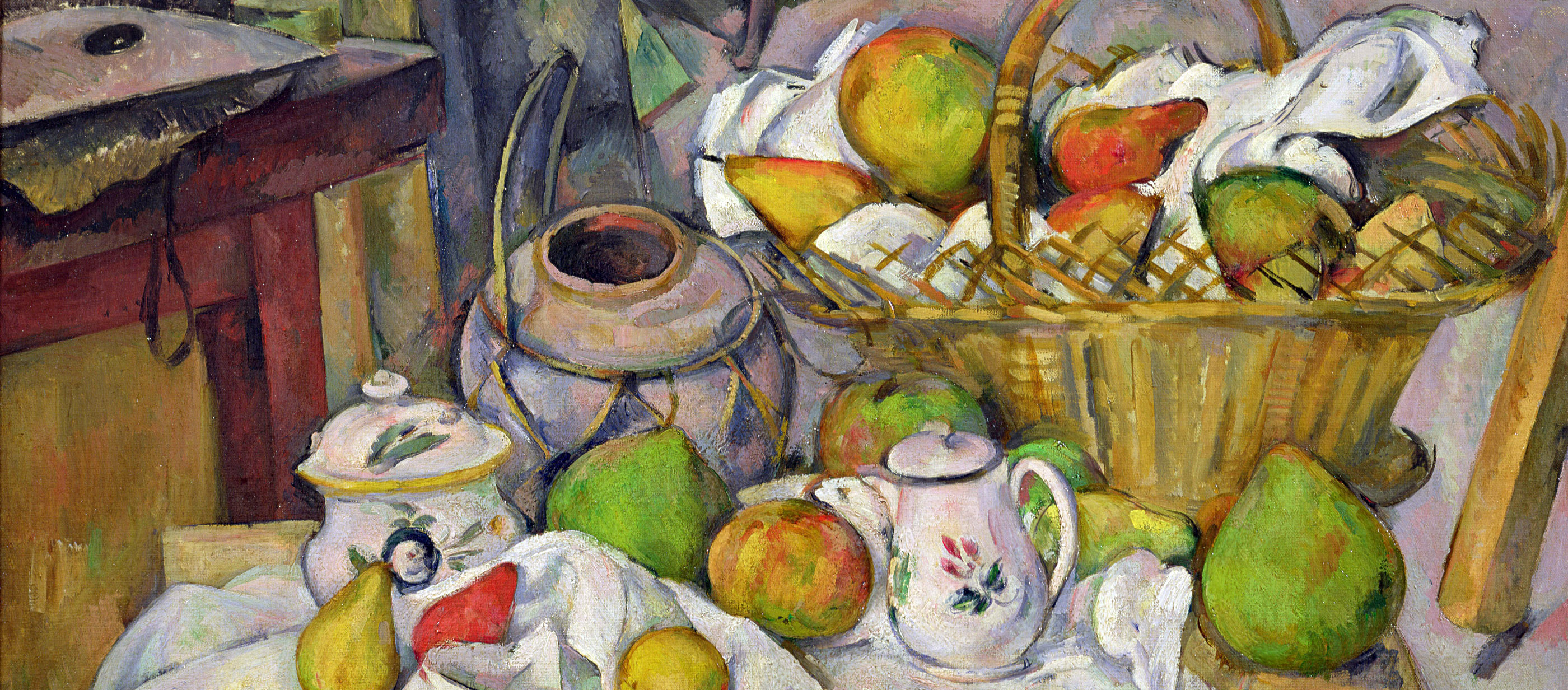
The Kitchen Table, by Paul Cézanne, c. 1889. Musée d'Orsay, Paris.
There was a temptation, then, to close the case. After all, there is an inherent beauty in this image of auto-regulation, this instinctual understanding of the mineral commerce that moves so invisibly through our blood. And yet there is also a problem. The lovesick girls did not crave foods high in iron, like red meat or leaf vegetables. They craved earth. And not just any earth. The Otomacs had not considered all clays “equally agreeable,” nor the “Negroes of Guinea” who sought vainly for caouac in Martinique. Across the world, the craved earths are mostly light-colored, crunchy when dry, aromatic when wet, easy to dissolve. Even modern pica cravings are highly specific—whether cornstarch or crushed chalk. There are Internet chat rooms devoted to ice cravings: the crushed ice of particular restaurants or the creamy flakes scraped from freezer walls. It is hard not to note that pica substances of the industrialized world tend to be light-colored, smooth, and powdery; on an “exposé” by the Tyra Banks Show, a craver of toilet paper spoke of her desire for the feeling of it “dissolving” in her mouth.
While one does not want to make too much of similarities between clay and toilet paper, one fact is true across almost every pica craving: they contain very little iron. If anything, the clays, with their high surface areas and binding capacities, cling to iron, blocking its absorption from the gut. This has even led researchers to blame not the craving on the anemia, but the anemia on the craving. It’s as if we are back at the question of blood vs. stomach, at those spirited debates in the Parisian Bureau d’Adresse, almost 350 years ago.
Perhaps we are not so well-wired after all. Perhaps pica is just an aberration, an accidental byproduct of our evolution, or a vestige that was once adaptive and hasn’t been lost. It is also possible that we have one part of the story right but not all of it. In Aristotelian terms, we might understand the material cause of the desire (i.e., micronutrient deficiency), but not why it takes this specific form. This then asks a more focused question. Not why we eat dirt, but rather why such a deficiency makes us seek out these particular dirts.
Queens and Acorn Meal
In 1930, Berthold Laufer, curator in the Department of Anthropology at the Chicago Field Museum of Natural History, published a hundred-page monograph called Geophagy. Laufer, a German-Jewish immigrant from Cologne, was an anthropologist of the old school, with an encyclopedic knowledge of languages and cultures, having studied Chinese, Japanese, Manchu, Mongolian, Tibetan, and most major European languages by the age of twenty-three. He was a deeply private man, “shy and sensitive,” with “few friends, no collaborators, and only a handful of intellectual successors,” practicing a form of deep textual analysis that was increasingly rare in anthropology.
Like the other publications from his final years (The Pre-history of Aviation, “The Lemon in China,” Felt), the range of his Geophagy was as wide as it was deep. Laufer left little doubt that earth eating had “nothing to do with climate, race, creed, culture areas, or a higher or lesser degree of culture.” Indeed, to read Laufer is to watch a war of attrition remove all notions of Otherness from our understanding of pica. He cites Humboldt, Cragin, and the seventeenth-century theories of vanity, but for the most part, the pica of his pages is quiet and reasoned, medicinal, culinary, religious. There is the sixteenth-century Bencao Gangmu, a massive Chinese materia medica with a chapter devoted to the uses of sixty-one species of earth and clay; the curative white earth from Mary’s cave at Bethlehem; the Chin practice of eating earth before an oath. There is the story of how Galen journeyed to the island of Lemnos to collect terra sigillata, a red clay stamped with the seal (sigillum) of Diana, still listed in pharmacopeias well into the nineteenth century. And there is a particularly lovely account from the epic Sanskrit poem Raghuvamsa, where the king of Ayodha smells the sweet earth on his pregnant queen’s mouth.
Most vegetarians I ever saw looked enough like their food to be classed as cannibals.
—Finley Peter Dunne, 1900But when it came to explaining these diverse forms of pica Laufer hesitated. “A formula applicable to the subject in its entire range can hardly be found,” he wrote, but then immediately went on. “When we hear that the Pomo Indians of California mix clay with acorn meal, their staple food, we may at first be inclined to dismiss this case as an unusual or queer practice; but when we further read that exactly the same thing is done by the peasants of Sardinia, we pause and think. As a historical contact between the Pomo and Sardinians is out of the question, the cause for this practice can only be physiological.” Again and again, he found that people used clay to cut the bitterness of foods. To the examples of the Pomo and Sardinians, he added, among others, that the Zuni ate white clay with wild potatoes; indigenous Australians with the root of the mene plant, the Hopi with wild berries.
It was, he wrote, humbly, “a matter that awaits the investigation of a physiologist.” But the implication of his litany was clear. Could clay allow us to eat the unpalatable, even the toxic? In a famous case history from 1581, a condemned criminal named Wendel Thumblardt had offered himself to science: in lieu of execution, he proposed to test the purported power of the terra sigillata of Lemnos by taking it with mercuric chloride. He survived and was freed.
Sweet Earth
Consider the potato. Today’s cultivated potatoes are the descendents of wild varieties domesticated in the Central Andes some eight to ten thousand years ago. Most wild potatoes still contain high levels of glycoalkaloids that render the tuber not only unpalatable but potentially toxic, damaging the gut wall and impairing nerve conduction. Humans deal with this toxicity in two principal manners: by the selective breeding of less bitter varieties (the kind found on American dinner tables) or by detoxification. The latter, still practiced in the Andes, is a complex process, involving freezing the potatoes, trampling them, leeching them in pools of moving water, then alternately drying and freezing them for storage. Or, as is also still practiced, they may be eaten with clays. That the clays cut bitterness, Laufer knew; what he didn’t know was how. More than fifty years after he wrote his monograph, those physiologists finally caught up with him, discovering that the preferred Andean clays bound glycoalkaloids, blocking them from being absorbed from the gut.
In other words, it is not earth itself that provides nutrition, but rather the other foods that earth allows us to eat.
The implications of these discoveries stretch far beyond the potato. We can imagine how ancient man chose which food to hunt, but how did he choose which foods to gather? Anthropologists speak of two competing impulses for any creature facing the bewildering array of wild plants: omnivory (our diet should be diverse) and neophobia (we fear the new). In times of plenty, there may be little tension between these: with a diverse diet, there is less pressure to try new foods. But in times of famine, we are driven to eat the unfamiliar: new roots, new leaves, new fruits, new bark. There is no time to learn the complex techniques of detoxification such as those practiced with potatoes in the Andes. So we protect ourselves with earth.
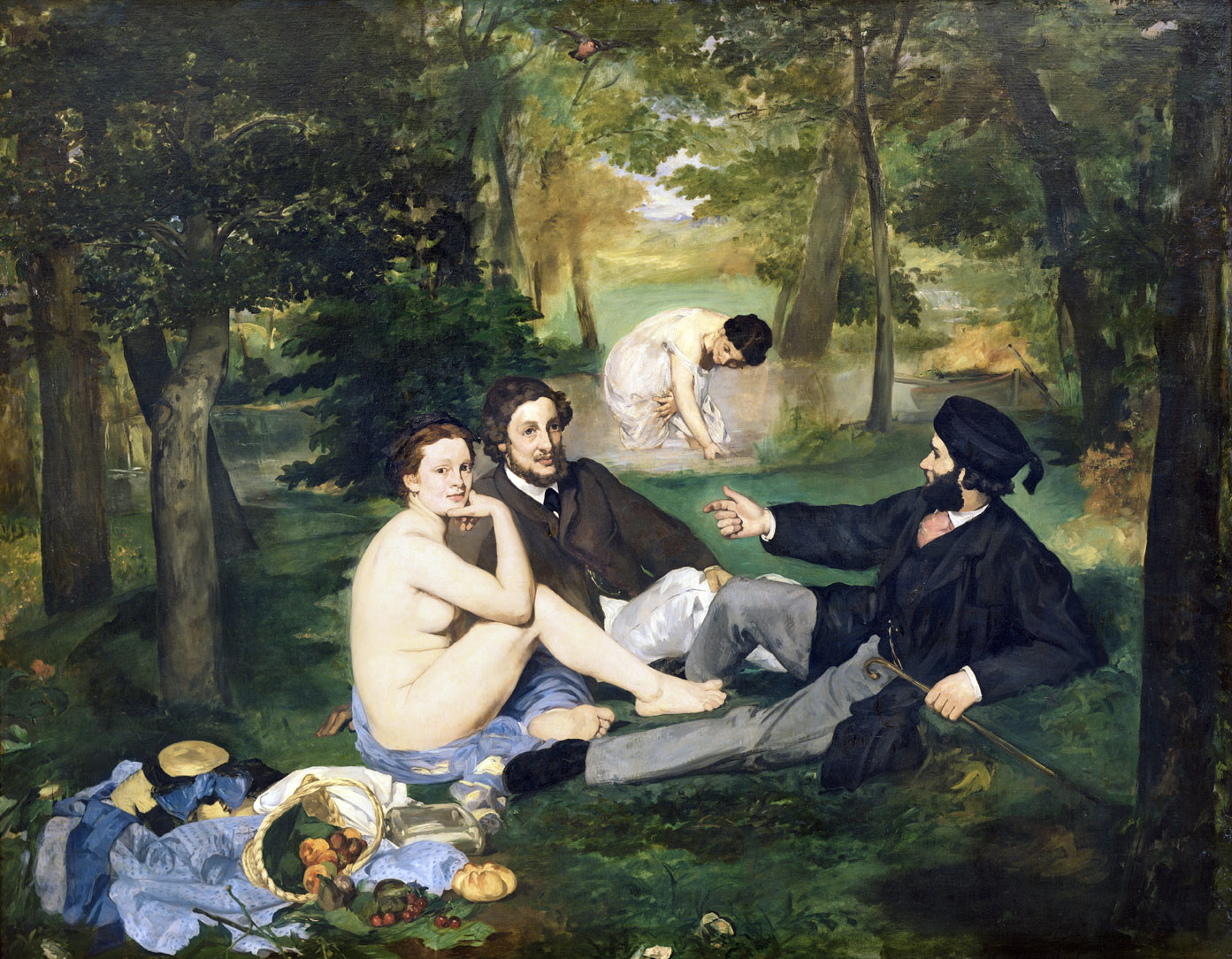
Luncheon on the Grass, by Édouard Manet, 1863. Musée d'Orsay, Paris.
In turning to geophagy to safely consume poisons, we are hardly alone. It is found in wild parrots eating bitter berries and in laboratory rats fed toxins. Over fifty species of primates practice pica; it seems difficult to argue that humans should be exempted. And for us, such instincts might be reinforced by learning: from our parents or even (Eve-like) the example of animals. After all, “taste” is almost entirely learned. We crave sweet and avoid bitter, but otherwise most of our likes and dislikes are based on either cultural traditions or the “postingestive experience” (if something makes us sick, it won’t taste so good the next time around). In other words, we can learn to like, or dislike, almost anything. One needs only to look at the diversity of our delicacies. We eat the molding (Brie, France), the fetid (durians, Malaysia), the live (casu marzu maggot cheese, Sardinia), even the human (placentas, which according to a recent scholarly article, is particularly “Californian”). There is little reason not to eat dirt, provided it’s not contaminated by human waste, and provided we eat it with enough of something else.
By this vision, craving earth is not a bizarre culture of the Other. The slaves on the Surinam plantations described by Cragin craved earth because they were malnourished or hungry or ill, or because of a rich tradition of the medicinal use of clay. It wasn’t just a “habit of their own country,” as Humboldt wrote, but either an effective prophylaxis, or a wise cure for a body in need.
And so too with the Otomacs at times of flood and famine. And the Hopi during their droughts. And the Sardinian peasant and the mystified ice cravers who post their confessions online. Like Wendel Thumblardt, bodies seeking cures.
As the distribution of pica across time and place and species makes itself ever more clear, we will surely learn this story is even richer, the culture practices subtler, the mineral commerce more complex. In some ways, our changing explanations of pica tell us more about the scientists and explorers than the very earth eaters they set out to describe. For now many mysteries remain, like how particular mineral deficiencies metamorphose into desire or along what channels of the mind such cravings sail. At the most, the story suggests an instinct within all of us, ready to emerge when famine strikes. At the very least, the tale—whispered by wolves and lovesick girls, discovered by a lonely anthropologist on the sweet breath of an Indian queen—suggests new views of who we are and what we eat.

